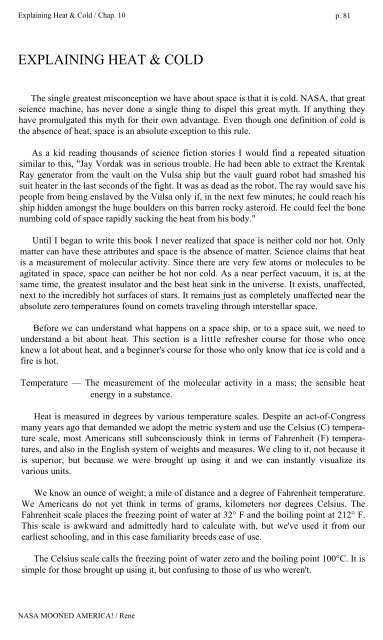Rene-NASA-Mooned-America
Rene-NASA-Mooned-America
Rene-NASA-Mooned-America
You also want an ePaper? Increase the reach of your titles
YUMPU automatically turns print PDFs into web optimized ePapers that Google loves.
Explaining Heat & Cold / Chap. 10 p. 81<br />
EXPLAINING HEAT & COLD<br />
The single greatest misconception we have about space is that it is cold. <strong>NASA</strong>, that great<br />
science machine, has never done a single thing to dispel this great myth. If anything they<br />
have promulgated this myth for their own advantage. Even though one definition of cold is<br />
the absence of heat, space is an absolute exception to this rule.<br />
As a kid reading thousands of science fiction stories I would find a repeated situation<br />
similar to this, "Jay Vordak was in serious trouble. He had been able to extract the Krentak<br />
Ray generator from the vault on the Vulsa ship but the vault guard robot had smashed his<br />
suit heater in the last seconds of the fight. It was as dead as the robot. The ray would save his<br />
people from being enslaved by the Vulsa only if, in the next few minutes, he could reach his<br />
ship hidden amongst the huge boulders on this barren rocky asteroid. He could feel the bone<br />
numbing cold of space rapidly sucking the heat from his body."<br />
Until I began to write this book I never realized that space is neither cold nor hot. Only<br />
matter can have these attributes and space is the absence of matter. Science claims that heat<br />
is a measurement of molecular activity. Since there are very few atoms or molecules to be<br />
agitated in space, space can neither be hot nor cold. As a near perfect vacuum, it is, at the<br />
same time, the greatest insulator and the best heat sink in the universe. It exists, unaffected,<br />
next to the incredibly hot surfaces of stars. It remains just as completely unaffected near the<br />
absolute zero temperatures found on comets traveling through interstellar space.<br />
Before we can understand what happens on a space ship, or to a space suit, we need to<br />
understand a bit about heat. This section is a little refresher course for those who once<br />
knew a lot about heat, and a beginner's course for those who only know that ice is cold and a<br />
fire is hot.<br />
Temperature — The measurement of the molecular activity in a mass; the sensible heat<br />
energy in a substance.<br />
Heat is measured in degrees by various temperature scales. Despite an act-of-Congress<br />
many years ago that demanded we adopt the metric system and use the Celsius (C) temperature<br />
scale, most <strong>America</strong>ns still subconsciously think in terms of Fahrenheit (F) temperatures,<br />
and also in the English system of weights and measures. We cling to it, not because it<br />
is superior, but because we were brought up using it and we can instantly visualize its<br />
various units.<br />
We know an ounce of weight; a mile of distance and a degree of Fahrenheit temperature.<br />
We <strong>America</strong>ns do not yet think in terms of grams, kilometers nor degrees Celsius. The<br />
Fahrenheit scale places the freezing point of water at 32° F and the boiling point at 212° F.<br />
This scale is awkward and admittedly hard to calculate with, but we've used it from our<br />
earliest schooling, and in this case familiarity breeds ease of use.<br />
The Celsius scale calls the freezing point of water zero and the boiling point 100°C. It is<br />
simple for those brought up using it, but confusing to those of us who weren't.<br />
<strong>NASA</strong> MOONED AMERICA! / <strong>Rene</strong>


